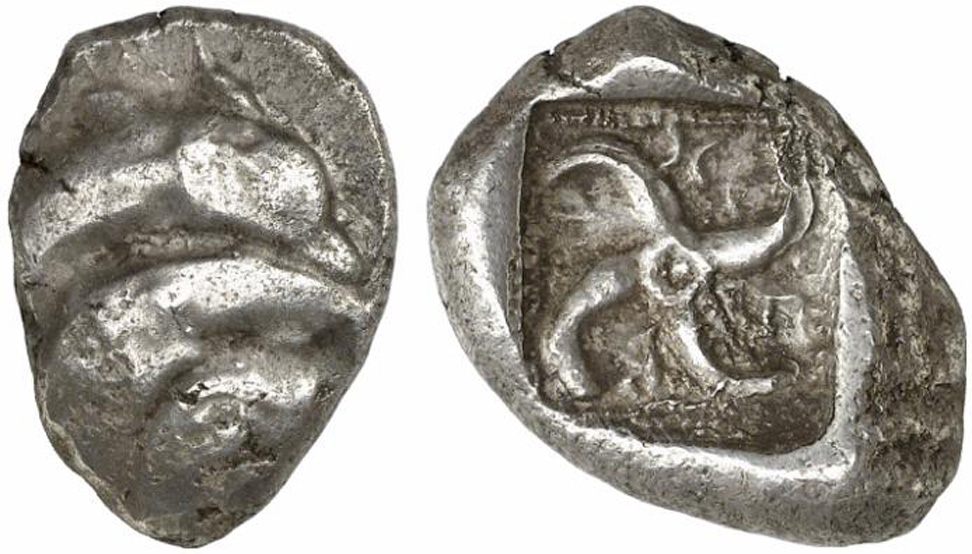Simena, silver, staters (two dolphins/tetraskeles in incuse square) (500-400 BCE)
From SILVER
500 BCE - 400 BCE Silver 3,598 kg
Description
| ObverseInscription or printing placed on the obverse.: | Two dolphins jumping over each other, eye in the lower field. |
| ReverseInscription or printing placed on the reverse.: | Tetrascele inside a quadrangular grenetis, all in a incuse square |
Mint and issuing power
| MintIdentifies the place of manufacture or issue of a numismatic object.: | Simena | Ancient regionAncient region.: | Lycia | Modern countryModern country: Turkey | AuthorityIdentifies the issuing power. The authority can be "pretended" when the name or the portrait of X is on the coin but he/she was not the issuing power. It can also be "uncertain" when there is no mention of X on the coin but he/she was the issuing power according to the historical sources: |
Chronology
| FromIdentifies the initial date in a range assigned in a numismatic context. | 500 BCE | toIdentifies the final date in a range assigned in a numismatic context.. | 400 BCE | PeriodTime period of the numismatic object.: Archaic until 480 BC |
Physical description
| MetalThe physical material (usually metal) from which an object is made.: | Silver |
Median weightMedian of the weights of numismatic objects (in grams). in grams | 9.60 | DenominationTerm indicating the value of a numismatic object. Examples: tetradrachm, chalkous, denarius.: | stater |
StandardStandard.: |
Image

AC263 Simena.jpeg [1]
References
| Die study referencePublication of the study: | Vismara 19961Vismara 1996 | ||
| Coin series referenceReference to coin series study: | Sear II2Sear II, n° 5190, RQEMAC3RQEMAC, n° 263 | ||
| Coin series web referenceCoin series web references: |
| ||
Obverse dies distribution
| FrequencyFrequency of specimen in distribution. ᵖ | Number of obversesNumber of obverse dies. ᵖ (o) | % (o) | Number of coinsNumber of coins. (n) | % (n) | Die nameName(s) of the die(s). |
| 1 | 4 | 36.36 | 4 | 19.05 | 40, 44, 49, 51 |
| 2 | 5 | 45.45 | 10 | 47.62 | 39, 43, 45, 48, 50 |
| 3 | 1 | 9.09 | 3 | 14.29 | 41 |
| 4 | 1 | 9.09 | 4 | 19.05 | 42 |
| Total | 11 of 11 | 99.99 | 21 of 21 | 100.01 |
Reverse dies distribution
no distribution is available
Quantification
| Number of obversesNumber of obverse dies. ᵖ (o) | 11 | Number of singletons (o1)The number of singleton coins. ᵖ | 4 |
| Number of reverse diesNumber of reverse dies. (r) | NC"NC" is not a number. | Number of coinsNumber of coins. (n) | 21 |
| Coins per obverse dieNumber of coins per obverse die. (n/o) | 1.91 | Coins per reverse dieNumber of coins per reverse die. (n/r) | |
| Reverse per obverse ratioRatio of obverse dies divided by reverse dies. (r/o) | Percentage of singletons (o1)number of coins (n) divided by the number of singletons (o1) ᵖ | 36.36 % | |
| Original number of dies (O) (Carter 1983 formula)The estimation of the number of coins according to Carter 1983 ᵖ | 18.74 | Coins struck if 20,000 as average productivity per dieCoins made if the average productivity for obverses (according to Carter) is 20,000. ᵖ | 374,800 |
| Original number of dies (O) (Esty 2011 formula)The estimation of the number of coins according to the singleton formula in Esty 2011 ᵖ (O) | 23.1 | Survival rate if 20,000 as average productivity per dieSurvival rate if average productivity is 20,000. ᵖ | 0.00006 |
| Coverage (o = % of O) (Esty 1984 formula)Esty 1984 - coverage (% of O) ᵖ (o = % of O) | 80.95% | Die productivity if survival rate 1/2,000Average productivity if survival rate is 1/2,000. ᵖ | 2,241.2 |
| Weight of silver (in kg) if 20,000 coins per die (O = Carter formula)Carter 1983 * Median weight * 20000 (*10 if gold or electrum) ᵖ | 3,598 kg <br /> 3,598 kg | Die productivity if survival rate 1/5,000Average productivity if survival rate is 1/5,000. ᵖ | 5,602.99 |
Remarks
Most likely one single workstation
References
- ^ Vismara, Novella (1996), Monetazione arcaica della Lycia. III. Le prime emissioni del Wedri. Le serie de Qa, della città di Qibanuwa (Simena), di Zagaba (Lagbe), di Zemuri (Limyra) e di Prl (Aperlai) e le emissioni federali di Ite e di Te, Collana di studi e ricerche di numismatica 6, Milan, Ennerre, XXIV-256 p.
- ^ Sear, David R. (1979), Greek coins and their values. Vol. II, Asia and North Africa, London, xlviii, p. 317-762
- ^ Callataÿ, François de (2003), Recueil quantitatif des émissions monétaires archaïques et classiques, Numismatique Romaine, Wetteren, VII + 267 p.